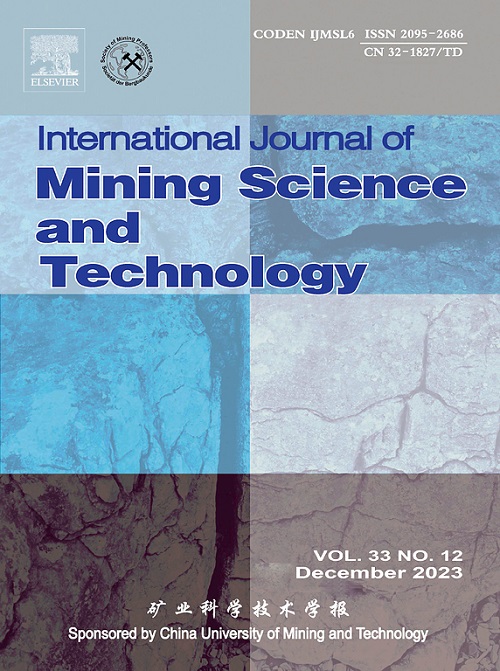Failure evolution and disaster prediction of rock under uniaxial compression based on non-extensive statistical analysis of electric potential
IF 11.7
1区 工程技术
Q1 MINING & MINERAL PROCESSING
International Journal of Mining Science and Technology
Pub Date : 2024-07-01
DOI:10.1016/j.ijmst.2024.07.008
引用次数: 0
Abstract
Rock failure can cause serious geological disasters, and the non-extensive statistical features of electric potential (EP) are expected to provide valuable information for disaster prediction. In this paper, the uniaxial compression experiments with EP monitoring were carried out on fine sandstone, marble and granite samples under four displacement rates. The Tsallis entropy q value of EPs is used to analyze the self-organization evolution of rock failure. Then the influence of displacement rate and rock type on q value are explored by mineral structure and fracture modes. A self-organized critical prediction method with q value is proposed. The results show that the probability density function (PDF) of EPs follows the q-Gaussian distribution. The displacement rate is positively correlated with q value. With the displacement rate increasing, the fracture mode changes, the damage degree intensifies, and the microcrack network becomes denser. The influence of rock type on q value is related to the burst intensity of energy release and the crack fracture mode. The q value of EPs can be used as an effective prediction index for rock failure like b value of acoustic emission (AE). The results provide useful reference and method for the monitoring and early warning of geological disasters.
基于电势非广延性统计分析的单轴压缩下岩石的破坏演化与灾害预测
岩石崩塌会引发严重的地质灾害,而电位(EP)的非广义统计特征有望为灾害预测提供有价值的信息。本文对细砂岩、大理石和花岗岩样品在四种位移速率下进行了带 EP 监测的单轴压缩实验。利用 EP 的 Tsallis 熵 q 值分析岩石破坏的自组织演化过程。然后通过矿物结构和断裂模式探讨了位移速率和岩石类型对 q 值的影响。提出了一种具有 q 值的自组织临界预测方法。结果表明,EPs 的概率密度函数(PDF)遵循 q-Gaussian 分布。位移速率与 q 值呈正相关。随着位移速率的增加,断裂模式发生变化,破坏程度加剧,微裂缝网络变得更加密集。岩石类型对 q 值的影响与能量释放的爆发强度和裂缝断裂模式有关。EPs 的 q 值与声发射(AE)的 b 值一样,可作为岩石破坏的有效预测指标。研究结果为地质灾害的监测和预警提供了有益的参考和方法。
本文章由计算机程序翻译,如有差异,请以英文原文为准。
求助全文
约1分钟内获得全文
求助全文
来源期刊

International Journal of Mining Science and Technology
Earth and Planetary Sciences-Geotechnical Engineering and Engineering Geology
CiteScore
19.10
自引率
11.90%
发文量
2541
审稿时长
44 days
期刊介绍:
The International Journal of Mining Science and Technology, founded in 1990 as the Journal of China University of Mining and Technology, is a monthly English-language journal. It publishes original research papers and high-quality reviews that explore the latest advancements in theories, methodologies, and applications within the realm of mining sciences and technologies. The journal serves as an international exchange forum for readers and authors worldwide involved in mining sciences and technologies. All papers undergo a peer-review process and meticulous editing by specialists and authorities, with the entire submission-to-publication process conducted electronically.
 求助内容:
求助内容: 应助结果提醒方式:
应助结果提醒方式:


